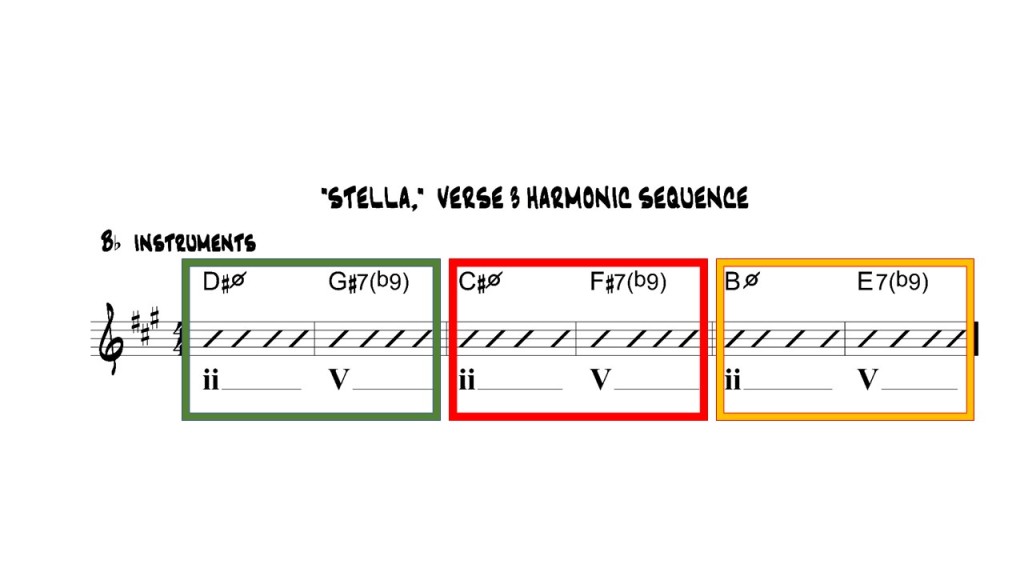Tenor saxophonist Brooklyn brought a favorite tune to his lesson. As always, we typed the changes into Band in a Box, chose a tempo and a groove, and started blowing on the tune. But Brooklyn said he was having trouble coming up with fresh ideas to play over the changes.
Tag: jazz solos
Rhythm in Your Bones!
 If you (or your students) struggle with playing swinging jazz rhythm, this video will go a long way toward gearing up those important rhythm chops. CLICK HERE TO WATCH THE RHYTHM VIDEO.
If you (or your students) struggle with playing swinging jazz rhythm, this video will go a long way toward gearing up those important rhythm chops. CLICK HERE TO WATCH THE RHYTHM VIDEO.
SUPERSTITION: Don’t Let It Rip Off Your Musical Spark !

CLICK HERE to view the video on YouTube. Click “continue reading” below to download the chart and background track or to read the script.
Continue reading “SUPERSTITION: Don’t Let It Rip Off Your Musical Spark !”
Blues in Benny Carter’s Heart
 Benny Carter blessed us with an amazing solo on the 1938 recording of his composition “Blues in My Heart.” The entire performance is miraculous, but one four-bar passage in particular knocked me out, prompting me to shed that phrase in all 12 keys. Here’s the lick:
Benny Carter blessed us with an amazing solo on the 1938 recording of his composition “Blues in My Heart.” The entire performance is miraculous, but one four-bar passage in particular knocked me out, prompting me to shed that phrase in all 12 keys. Here’s the lick:
Benny’s rhythmic vitality propels the piece, his melodic contour is unique in all of jazz literature, his harmonic inventiveness is preposterously original, and his crystal clear tone is infectious. Here is my transcription of those amazing four bars.

Here is a slowed down recording of that phrase in all 12 keys:
If you want to play it yourself, click the “continue reading” button to see a complete chart.
Stan’s Stella Sequence

Yesterday, I discovered a sequence in Stan Getz’s 1952 Clef recording of “Stella by Starlight,” (MGC 137). The three-by-three format unfolds as Stan finishes the bridge on his first chorus. Here it is:

If you’ve studied “Stella,” you know that the final 8 bar section of the form contains the intriguing 6-bar harmonic sequence shown below:

As shown here, that harmonic sequence features 3 iterations of 8 beats each, for a total of 24 beats. But Getz begins his amazing melodic sequence 2 beats before the passage shown above, so he needs to fill 26 beats.
The diagram below illustrates the incredible way he accomplishes this Herculean feat. Stan’s motif of six eighth-notes covers 3 beats and is repeated three times on each of three starting notes. But on the second iteration of round two, he leaves out a beat. Thus, the total episode comprises 9 + 8 + 9 = 26 beats. Even at 160 beats per minute, Getz is able to execute this monumental feat so smoothly that it sounds effortless.

How Sonny Rollins Practices
How has the quarantine impacted your chops? This no-gigs lock down has been absolutely disastrous for many working musicians financially. But our chops don’t have to take the same hit our wallets are taking, if we’ll explore innovative approaches to practicing.
My practice strategy is similar to what Sonny Rollins described when asked how he practices. Sonny said:
“I start out playing things I know to get the blood flowing. Those things are often described as ‘clichés.’ You begin with the cliché so you can get the process in motion. Once the process is in motion, ‘thinking’ gives way to ‘playing.’ At that point, you get out of the way and let the music play.”
Over the past decade, I’ve written down over a thousand licks I keep in a notebook, each of which I woodshed in all 12 keys. Some of these ideas come from transcribed solos of the masters, but most simply emerge as I’m connecting with the horn. Practicing joy. I encourage you to try this technique, as it supercharges your chops, strengthens your improvisatory muscle, and turns you into a composer.
Here’s a lick you can play with, in order to get started down that path. The tonal center of this phrase baffled my friends and me at first. Eventually, I settled on a basic ii-V-I progression, which perfectly fit the melodic contour. If you want more background, leave a comment at the bottom of this post.
To see a chart, click on “CONTINUE READING” below.
“Remember” Hank Mobley’s “Soul Station”?
 The road to dynamic, expressive improvisation is paved with practice and listening. Hank Mobley’s near perfect solo on Irving Berlin’s “Remember” from his classic LP “Soul Station” is filled with profound lessons on phrasing, rhythm, tone, melody, pacing, and development. Here is just one of the great ideas you will encounter when studying this wonderful recording.
The road to dynamic, expressive improvisation is paved with practice and listening. Hank Mobley’s near perfect solo on Irving Berlin’s “Remember” from his classic LP “Soul Station” is filled with profound lessons on phrasing, rhythm, tone, melody, pacing, and development. Here is just one of the great ideas you will encounter when studying this wonderful recording.
 As always, we recommend learning the phrase in all 12 keys. Practice with the audio file found below. Continue reading ““Remember” Hank Mobley’s “Soul Station”?”
As always, we recommend learning the phrase in all 12 keys. Practice with the audio file found below. Continue reading ““Remember” Hank Mobley’s “Soul Station”?”
Why Is This Tune So Hard To Memorize?
Have you ever had difficulty playing a tune, even though it presented no obvious technical hurdles? Perhaps the problem lies in a hidden harmonic riddle, which, when solved, will unlock your understanding of the song and make it easier to play and to remember.
At a recent gig, pianist Mark Schecter called off Dizzy Gillespie’s “Groovin’ High.” Although Storyville used to play the song, it still made me stumble. However, after deciphering its harmonic implications, playing it became simple.
Here’s how to solve a riddle like that.
How to Learn Songs
Is there a more effective, efficient method for learning and retaining a large repertoire of jazz standards? Continue reading “How to Learn Songs”
Thematic Development Galvanizes Your Solos
 Do your solos brim with vitality, gliding across a colorful landscape, as you explore ever deeper into the ocean of sound? Or do you flounder among waves of notes, swimming through a maze of chord changes?
Do your solos brim with vitality, gliding across a colorful landscape, as you explore ever deeper into the ocean of sound? Or do you flounder among waves of notes, swimming through a maze of chord changes?
 Thematic development will transform your playing, as you weave your exciting, personal story.
Thematic development will transform your playing, as you weave your exciting, personal story.
The following clips illustrate three powerful tools to stimulate your creative potential and enthuse your audience.
1. RHYTHMIC SHIFT – Example 1 presents a 7-beat phrase that starts on the “and” of beat 3. The phrase is then repeated, but this time, it begins on the “and” of beat 2. Repeating the phrase gives your thought unity, while the rhythmic offset offers variety and surprise. Try playing along with this recording in all 12 keys.
2. DIMINUTION – In example 2, the 7-beat phrase is the same, but a triplet compresses the second statement of the theme. Your motif is still easily recognized, but you have added variety.
3. TONAL SHIFT – In Example 3, the second statement of the theme modulates up a minor third. Tonal shift was a favorite device of John Coltrane. The listener still recognizes your theme, but her ear delights in this fresh new element you have added to the mix.
As you become more comfortable with creating and developing thematic material, your unique personality defines your individual style. You improvise dynamically and coherently.
To master these 3 techniques, play along with the 3 audio files offered here. Contact me, if you need a chart. Or, if you want to learn to play by ear in all 12 keys (as I did while recording these clips), download “New Ears Resolution” and liberate your musical imagination!
Do You Enjoy Practicing Scales?
How often do we teachers hear students complain about having to practice long tones and scales? Every teacher knows that long tones greatly enhance tonal quality and intonation and that scales are the raw material from which improvised solos are crafted. The problem is that any musician who practices being bored will bore the audience. What you practice is what you perform. Practice joy, imagination, and freshness, and your show will be fresh. Practice dry technique, and your gig will be a desert.
Below is a 4-bar phrase containing a descending major scale (Ionian mode) and an ascending Mixolydian mode. I worked on this exercise until the rhythm and note sequence started to feel interesting to me.
Try playing along with the background track provided below and see if this approach adds a bit of zest to your practice time. Develop your own variations on this idea. Email me for a FREE copy of this exercise in all 12 keys, if you have trouble figuring it out. Better yet, download “New Ears Resolution” and learn how to play any melody in any key by ear.
Check Out This Great Saxophone Web Site
Jeff Rzepiela is a talented reed player and arranger. His web site contains many transcriptions of solos by the masters of jazz. Check out his latest newsletter Scooby-sax_Newsletter_Oct_2014(1) which features an insightful analysis of an improvised solo by Arnie Krakowsky over the tune “I’ve Never Been in Love Before.” Jeff skillfully singles out several key phrases in the solo, shows how they relate to each other, and makes them available for those of us who benefit from “wood-shedding” over great “licks.”





